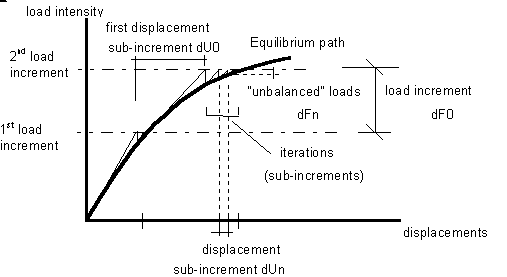Non-linear analysis consists of incremental application of loads. In calculations, loads are not considered at a time, but are gradually increased and solutions to successive equilibrium states are performed.
Non-linear behavior of a structure may result from a single structure element (structural or material non-linearity) or from a non-linear force-deformation relation in the whole structure (geometric non-linearity).
Structural non-linearity may be caused by the following non-linear elements included in a structure:
- Compression / tension elements
- Cable elements
- Non-linear constraints (unilateral constraints or supports, releases, compatible nodes with the rigid parameter assigned)
- Material plasticity
- Non-linear hinges.
Selecting geometric non-linearity considers the following effects for the whole structure:
- Non-linear analysis - takes account of the second-order effects, such as changing the stiffness of the element under the influence of the stress state in the element. At the same time, this analysis considers generation of moments resulting from the action of vertical forces at the nodes displaced horizontally.
- P-delta analysis - takes account of the third-order effects, such as the additional lateral rigidity and stresses resulting from deformation. This effect considers additional forces arising in a deformed structure such as a beam with fixed supports on both ends, loaded by a vertical load, longitudinal forces arise and the deflection decreases.
Selecting geometric non-linearity takes the actual higher-order effects into consideration and often has effect on improving the convergence of the calculation process for a structure including non-linear elements.
Incremental or arc-length methods solve a system of non-linear equations.
In the incremental method, the right-hand load vector is divided into n equal increments. A consecutive load increment is applied to the structure once the state of equilibrium for the previous increment is achieved. The norm of unbalanced forces is specified for each step, allowing for monitoring of the structure force-deformation relations.
The arc-length method of displacement steering should be applied when the incremental algorithms of solving equations by force steering are not convergent.
An example of the non-linear process within the incremental method is shown in the following figure. Values used for non-linear calculations are displayed.

To select one of the three available algorithms for solving a non-linear problem, set the following parameters of non-linear analysis:
- For the Initial stress method - Matrix K actualized after each subdivision - Off.
Matrix K actualized after each iteration - Off.
- For the Modified Newton - Matrix K actualized after each subdivision - Off.
Raphson method: Matrix K actualized after each iteration - On.
- For Full Newton - Matrix K actualized after each subdivision - Off.
Raphson method: Matrix K actualized after each iteration - On.
The algorithm of the Broyden-Fletcher-Goldforb-Shanno (BFGS) procedure modifies the stiffness matrix during calculations. In certain cases, the use of the line search algorithm may improve the convergence of the method.
In general, the quickest way to get the solution of the problem is to apply the Initial Stress method, while the calculations take the longest time when the user decides to select Full Newton-Raphson method. However, the greatest probability of obtaining convergence of a method in the case of Full Newton-Raphson, while the probability is the smallest in the case of Initial Stress method.
The convergence of the process is checked and the iteration process is stopped once the state of equilibrium is achieved. Displacement increments dUn and unbalanced forces are essentially zero (sufficiently small in comparison with the tolerance parameters for both values). The iteration process is stopped in the case of divergence. Lack of convergence can be interpreted either as the numerical effect of structure overloads or as a result of numerical process instability (such as when the load is divided into a small number of intervals). In such cases, the number of load increments can be increased, which usually helps the process to converge.
Click Parameters to access the following, which influence the course of non-linear calculations:
- Load increment number is used when dividing a load into smaller segments. For complex structures where the impact of non-linear effects is considerable, calculations may not converge if the analysis for the value of a load is applied in one step. The number of load increments influences the number of calculation iterations. The greater the number of increments, the greater the probability for the calculations to reach the point of convergence.
- Maximum iteration number in each load increment is used to control the calculation process during one load increment.
- Allowable increment length reduction number (modification) defines how many times the number of load increments can be changed when calculations do not reach convergence (refer to the increment length reduction factor below).
- Increment length reduction factor is used to modify the required number of load increments. This is the conditional option, used only when calculations do not reach convergence for the currently defined parameters. If convergence is not achieved, the size of load increment is reduced (depending on the value of the coefficient) and calculations continue. This is repeated until convergence is achieved or the iteration process exceeds the allowable number of step length reductions.
Click Parameters to access the following arc-length method parameters.
Load increment number.
- Maximum iteration number for one increment.
- Maximum load factor λmax - The maximum value of the load parameter.
- Node number, degree of freedom - Specify the number of a node located on a structure roof and displacement direction, respectively.
- Maximum displacement for selected degree of freedom Dmax - The maximum value of a displacement at a selected node.
The Arc-length method is applied during non-linear pushover analysis. It is strongly recommended when non-linear structure attributes are defined in a structure model (see the appendix).
In the Non-linear Analysis Algoritm Options dialog there is also the Additional criterions to stop analysis button. When clicked, the Criterions to stop analysis dialog Opens.
See also: